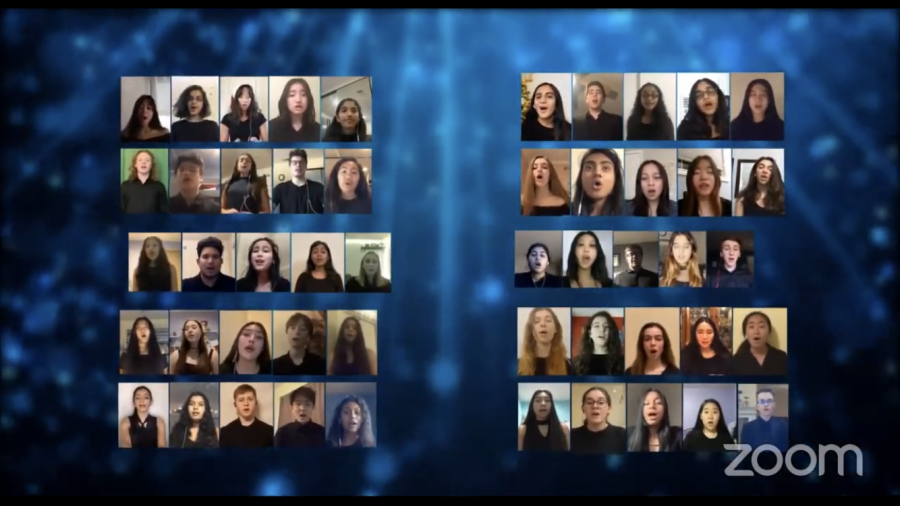Remote learning affects arts and other hands-on classes
Student musicians, artists and interns struggle to get similar experience from online classes
Cal High choir students performed virtually on Sunday at the Celebration of Christmas performance.
Choir. Band. Ceramics. How do these hands-on classes work in an online format?
Classes such as English and math are arguably easier to transition to remote learning, but this is not the case for hands-on classes since they’re structured to be taught in a face-to-face format.
“It is very different because when we were actually in school, we could play music together,” junior band student Gracie Neves said. “On Zoom, you have to do things by yourself and you have to play by yourselves.”
Students and teachers alike have had to adapt to the new format.
“Since we cannot play together in real-time via online conference platforms, students generally can share audio/video recordings of themselves performing repertoire or technical studies,” band teacher Matthew Smith said.
In choir, the new format also entails students taking recordings by themselves and not singing with classmates. Many students feel that the virtual setting has affected their experiences in the class.
“Singing alone is never going to be the same as singing with your friends,” senior Brooklyn Miravelles-Calceta said. “Going from in-person singing to video submissions is not as fun as it was when choir was in person.”
For classes such as ceramics, students had to pick up clay from school to get somewhat of a normal experience for the class. Ceramics teacher Carrissa Bowman adds resources onto Google Classroom to make sure students get adequate resources, but not everything from the content of the class can be implemented online.
“We actually had to make tools from things we had at home, like paper clips,” senior ceramics student Srujana Miryala said. “We had to make them into makeshift tools because we didn’t have actual tools that we would be using in class.”
For students taking hands-on classes for the first time at Cal High, remote learning is disappointing since they are not getting the same format of the class as they had hoped for when they signed up before the coronavirus pandemic.
“Not getting the experience of playing [cello] in-person is also disappointing since this is my first year playing for Cal,” freshman Mary Neves said. “I have not been able to get the same band experience in the usual format.”
There are still technical complications as expected with this new way of learning even halfway through the year.
“Zoom also has its share of sound transmission problems when you’re singing sometimes,” choir teacher Lori Willis said. “The higher frequencies tend to make things cut out.”
Willis now has a better grasp on the technical side of running her classes, and her choir even contributed to a recent virtual Celebration of Christmas performance. (Note to viewers: Cal’s choir comes in at the 13:30 mark).
With many remote classes starting to hit their stride, many Cal students and staff are a little skeptical about the hybrid model and how that may further affect how classes are already functioning smoothly.
The San Ramon Valley Unified School District was planning to welcome some students back on campus in a hybrid model beginning Jan. 5. But at Tuesday night’s Board of Education meeting, this plan was postponed while Contra Costa County remains in the most restrictive purple tier.
“There has been some talk about the whole going outside and having choral classes outside,” Willis said. “[The administration] needs to understand [outdoor choral classes] will make things worse for us singers.”
Willis said the hybrid model can disrupt the routine and consistency of the class, making everyone adapt to another new way of learning despite the various changes that have already been implemented this year.
The hybrid model may also affect the Careers-in-Teaching class that aims to give students a pathway to their future teaching careers.
In the original format, students interned with teachers at other district schools so they could observe real-life teaching methods. This semester, Careers-in-Teaching students simply logged into the class they were interning for and observed from a virtual setting.
“Personally, I am hesitant with the hybrid model just because of COVID and the cases rising so rapidly,” senior Emily Crkenvac said. “For Careers-in-Teaching, students in the class have the option and ability to go into their classroom whether they chose remote learning or hybrid learning.”
There are many pros and cons to the hybrid model. Students are more worried about how their teachers are going to manage the two ways of teaching as they don’t know the actual way classes are going to work once campus finally reopens.
“Till now [Bowman] has just been teaching the same things for all of her classes,” Miryala said about her ceramics class. “But for people who are actually in class, it will probably be a lot harder for her to teach in different styles to different groups.”
All of these alterations for hands-on classes hasn’t been easy to transition to and with the hybrid setting, more changes are yet to come, but students will just have to see how the rest of the year unfolds.





